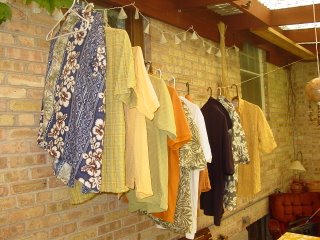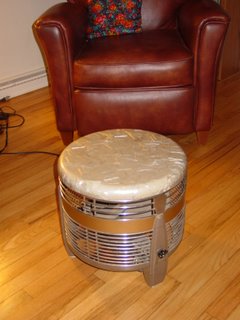Friday, January 26, 2007
Exreme Energy Efficiency
1. I rarely heat my home over 62 degrees. To stay warm I wear, undershirts, vests, wool socks and house shoes. Why over heat all 10,000 cubic feet of my home when only about 6 cubic feet (i.e. my body) needs to stay warm? At night my thermostat is set at about 52 degrees. I love sleeping cold under a warm down comforter (Mine is from Wisconsin's Company Store). Yes, if I had a partner, I would be fine turning up the heat.
2. My eight-year old son turns off lights when he leaves a room
 3. I line up the items I want to place in the refrigerator beside the refrigerator - and then open the door part way and quickly put everything away
3. I line up the items I want to place in the refrigerator beside the refrigerator - and then open the door part way and quickly put everything away4. I wait until food cools off before I put it in the refrigerator
5. During the home heating season, I leave the hot dishwater in the sink until it cools off (yup, I do it with shower water too).
 6. I used my clothes dryer once in the last 20 months (actually my German aunt used it). See right, I line dry instead
6. I used my clothes dryer once in the last 20 months (actually my German aunt used it). See right, I line dry instead7. My outside doors are so well weatherstripped that my son has to work at opening them
8. I have a masonry house (i.e., rock walls (i.e., terrible r-value (i.e., no insulation))), but it is a beautiful 1100 square foot brick house. So I made my small bedroom even smaller - by studding out the walls, insulating, doing the electric, drywalling, etc.
 9. I have some really cool fans (including a whole house fan) to keep me cool in the Summer. I got the floor fan in the picture from the University of Wisconsin's property disposal folks for $1. It was in the winter and my now ex-wife thought I was nuts. It is very 60ties and I dig it (can also be used as an ottoman)
9. I have some really cool fans (including a whole house fan) to keep me cool in the Summer. I got the floor fan in the picture from the University of Wisconsin's property disposal folks for $1. It was in the winter and my now ex-wife thought I was nuts. It is very 60ties and I dig it (can also be used as an ottoman)
10. Oh yeah, I grow a lot of my own food
If you have some good (or stupid) energy efficiency items - share them in the comments section (yeah, I know it is a pain to sign up.)
Wednesday, January 24, 2007
Icicles on the Roof - Equals a Poorly Insulated Home
I took these pictures yesterday morning, two days after a five inch snow fall. Temperatures have not been above freezing since. Many older homes are "cooking" the snow off their roofs and making icicles and ice dams.
Remember these are Cape Cod homes. In a Cape Cod the second floor rooms are built under the roof. They have a:
1. lower vertical wall, called the knee wall (with a craw space between the knee wall and the roof),
2. an upper angled wall (angled at the same pitch as the roof) and
3. a flat ceiling (with a small true attic above it).
 The home in the first picture has a warm attic. Most likely, there is not enough insulation above the flat ceiling in the attic area. Note, the large beautiful icicles.
The home in the first picture has a warm attic. Most likely, there is not enough insulation above the flat ceiling in the attic area. Note, the large beautiful icicles. The second Cape Cod does not have enough insulation between the angled upper wall and the roof. This is common because the space is typically only six inches wide and also should allow air flow between the crawl space and the attic. Sadly this is not easy to fix (everything else that I mention here is relatively easy to fix). Meanwhile the attic looks pretty well insulated.
The second Cape Cod does not have enough insulation between the angled upper wall and the roof. This is common because the space is typically only six inches wide and also should allow air flow between the crawl space and the attic. Sadly this is not easy to fix (everything else that I mention here is relatively easy to fix). Meanwhile the attic looks pretty well insulated.

This house looks pretty good. But note the one area where the snow is melting just to the right of the chimney. In a Cape Cod the crawl space is often used for storage, either by building shelving units into the crawl space or by putting little entry hatches in the knee wall that allow people to store "stuff" in the crawlspace. If either the built-in storage units or the entry hatches are not air tight they will leak warm air and cause snow melt above them.
Also, note in the third picture that snow is melting from around the chimney. This means that inside-the-home air is running up the chimney chase and melting snow around the chimney.
Heat rises. So warm air is pressing against a Cape Cod's second floor ceiling with more "pressure" than anywhere else in the home. The ceiling and the walls need to be air tight.
All these houses were built in about 1950. It could be that for those fifty years they would have been 20% more efficient with better insulated and tighter second floor areas. That 20% heat losses would have heated the homes for about 10 years.
So look at your roof, after a snow or a frost, and see how it is doing. If you have icicles or is melting some areas before others it probably needs work and is wasting you money and wasting the planet's natural gas.
To get a better idea where the air leaks are, get a blower door test. In Wisconsin contact Focus on Energy to line one up (www.focusonenergy.com).
This is something real that you can do to reduce global warming and your energy bill. And everyone that lives in your house in the future will benefit as well.
Tuesday, January 23, 2007
Bush's Words: Music to My Ears - OK a few notes
Our president in tonight's State of the Union speech: called global climate change a SERIOUS challenge. Give up all you nay sayers of global climate change (also known by its scarier name "global warming"). Give it up Mr. Exxon, you too Mrs. Peabody Coal.
The writing is on the wall... there will be a national carbon tax of one type or another soon. Mr. Exxon and Mrs. Peabody and boy Ford... you better start rethinking how you do business.
Other musical notes included this: "We must continue changing the way America generates electric power - by even greater use of clean coal technology ... solar and wind energy ... and clean, safe nuclear power.
Ok, well two of the notes were sour: "clean coal" (an oxymoron) and "clean, safe nuclear power" (that is a double oxymoron?). At least he didn't call nuclear power “renewable” as the president has in the past (thank you Mr. Speech Writer).
But he mentioned "wind and solar energy"! That is music to my ears.
Who opened our President's eyes to solar power? Why none other than Stanford R. Ovshinsky - genius, old guy, hero of many, and founder of UniSolar (a.k.a. Energy Conversion Devices or Ovonics ECD). Rumor is that President Bush met with him about a year ago at UniSolar's Michigan solar plant, and Stanley told him about solar electric systems and how they could be on the roof of a home and generate its power needs. Bush loved it and he has spoken about it since. That was a home run, Mr. Ovshinsky, Thank you.
Sadly, President Bush did not say: it is time we put a limit on the amount of carbon dioxide the US emits. But hey, he has come a long way. Remember last year he announced that we are "addicted to oil". Maybe next year he'll admit that we need to do something serious about climate change.
Wednesday, January 10, 2007
Back of the Envelop Calculations and Comments: CitizenRe
CitizenRe owns the system
Home owners pays monthly “based” on currently billing rate and systems production
For 25 years
Lets look at the economics.
Example Best Case Scenario
System cost per kilowatt
Anyone that is selling systems today must use today’s prices. This cost estimate is lower than anyone can get, for a small system, while covering their costs:
Panels: $4,000/kW
Inverter: $700/kW
Balance of System: $500/kW
Rack: $325/kW
Tax: $260/kW
Labor: $650/kW
Shipping: $65/kW
Additional payments to CitizenRe field staff etc: ~$250/kW
Total cost: $6750/kW
Let’s assume CitizenRe’s Corporate costs for are ZERO!
Marketing: $0/ kW
Contracts and Administration over 25 years: $0/kW
PV System data collection and billing over 25 years: $0/kW
PV system maintenance over 25 years: $0/kW
Cost of money over 25 years: $0/kW
My guess is that these costs equal the system’s cost.
If Citizen’s RE owns the system they get:
30% federal tax credit on installed cost of the system: $2025/kW of system
Accelerated depreciation over the first five years of systems cost
Assuming they are at a 35% tax bracket: $2010/kW
System cost after Federal tax credits: $2715/kW
Payments to CitizenRe: Madison Gas and Electric customers
According to their own calculator MGE power is: 11.7 cents/kWh
A one kW fixed mounted system in the full sun with no snow cover will generate about: 1250 kWh/year
So customer payments would be $146.25/year or $3,656 over 25 years
CitizenRe Return on Investment: MGE Customers
Based on all my assumptions (Zero CitizenRe corporate costs), CitizenRe would make a profit of about $940/kW over 25 years on an investment of $2715
That is a 35% return over 25 years, or less than 2% return per year
Payments to CitizenRe: North Dakota Ottertail Customers
According to their own calculator Ottertail’s power is: 7.2 cents/kWh
A one kW fixed mounted system in the full sun with no snow cover will generate about: 1350 kWh/year in ND
So customer payments would be $97.20/year or $2430 over 25 years
CitizenRe Return on Investment: Ottertail customers
Based on all my assumptions (Zero CitizenRe corporate costs), CitizenRe would lose about $285/kW over 25 years on an investment of $2715
Summary: When evaluating a business plan venture capital investors are looking for returns of 1000% over a three to seven years. CitizenRe does not look like a workable business model.
Second set of Comments
CitizenRe notes that they need a 7 cent/kWh net metered rate to break even. At the noted 7 cents/kWh for 25 years in Wisconsin – the customer would pay $2,1875 to CitizenRe per kW of system assuming a discount rate of zero.
If we assume a discount rate of 8% the customer's payments are worth $970/kW over 25 years. So simply the time value of money reduces their net income, be it from kWh or REC sales, by about 65% over the 25 years!!
Regarding CitizenRe’s claims of vertical integration: Check out Conergy - they have economics of scale and vertical integration today http://www.conergy.de/en/PortalData/2/Resources//investor_relations/pdf/CGY_CompanyPres_HVB_9-06.pdf see slide six, etc. It does not reduce system cost by 50%
Regarding CitizenRe’s claims of plug and play: Maybe "plug and play" could work on a row of identical homes as they are being built in a new sub-division, with the same roof exposure and all the homes getting solar at the same time (that is what CA's new PV program is about).
Talk to any installer about putting PV on existing homes - about plug and play - and they will laugh at you. Just about every system is different, no mater how hard they try to sell similar systems.
Installers would also laugh about a CitizenRe’s claimed 4 to 6 hour installation time (for a 2 kW system). That would about cover travel and being there for the utility interconnection testing.
Regarding their claim of reducing the production cost of modules and passing it on to consumers. Any business that sells modules, sells them at the market price. If you are a low cost producer, say SunTech Power, you sell them at roughly the same price as all the other producers, but you make a lot more profit.
Once you are able to do that, your stock prices goes nuts, and the owners, stock holders and venture capital investors all make a killing (again see SunTech Power). The CEO of SunTech Power is now the richest man in China.
CitizenRe's 1000 MW module production facility is only words - in other words hype. If they really had something they would go the way of SunTech Power (go the IPO route to make a quick killing) or NanoSolar (Use venture capital funding and stay private). Also, where is their silicon supply contract for the production facility, where are their investors, where will it be located (note, low cost production is in Asia), etc?
Why offer they same deal cross the country when some people net meter at 40 cents/kWh and other 5 cents/kWh? And when there are different amounts of sunshine and state incentives, etc. This makes no business sense. Instead it makes business sense to go where the best opportunity is (see SunEdison, whose is in CA, NJ etc., and on commercial buildings.)
If CitizenRe argues efficiency of scale why go on residential homes? Boring flat commercial roof are much easier, larger, more common, sunnier, etc.?
CitizenRe claims significant income from Renewable Energy Credit (REC) sales. Today, there is no solar REC market in most of the US, so I have no idea what their value would be. I do know that some utilities in the country would say that because they provided net metering they should own the RECs (some incentive programs want to own the RECs too). This would need to be determined for all they states CitzenRe work's in before their business model is complete.
Investors/banks... have no interest in any business models that takes 25 years to cover costs.
That is about all I have to say about CitizenRe.
These are my opinions only.